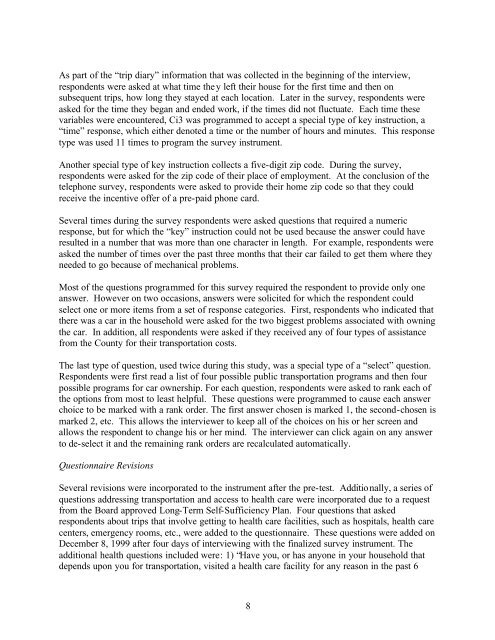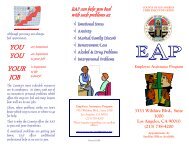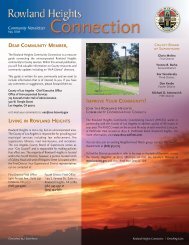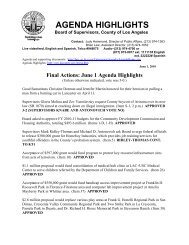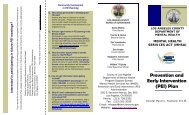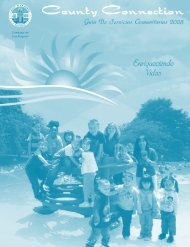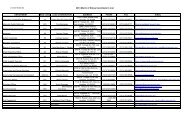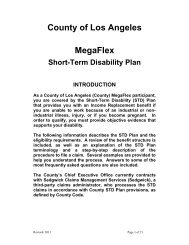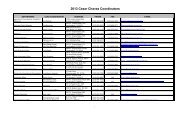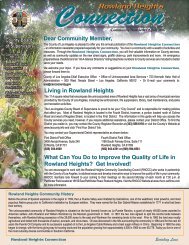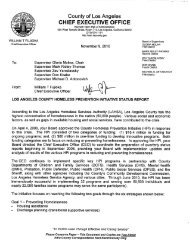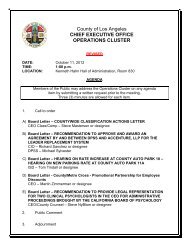assessing the transportation needs of welfare-to-work participants in ...
assessing the transportation needs of welfare-to-work participants in ...
assessing the transportation needs of welfare-to-work participants in ...
You also want an ePaper? Increase the reach of your titles
YUMPU automatically turns print PDFs into web optimized ePapers that Google loves.
As part <strong>of</strong> <strong>the</strong> “trip diary” <strong>in</strong>formation that was collected <strong>in</strong> <strong>the</strong> beg<strong>in</strong>n<strong>in</strong>g <strong>of</strong> <strong>the</strong> <strong>in</strong>terview,<br />
respondents were asked at what time <strong>the</strong>y left <strong>the</strong>ir house for <strong>the</strong> first time and <strong>the</strong>n on<br />
subsequent trips, how long <strong>the</strong>y stayed at each location. Later <strong>in</strong> <strong>the</strong> survey, respondents were<br />
asked for <strong>the</strong> time <strong>the</strong>y began and ended <strong>work</strong>, if <strong>the</strong> times did not fluctuate. Each time <strong>the</strong>se<br />
variables were encountered, Ci3 was programmed <strong>to</strong> accept a special type <strong>of</strong> key <strong>in</strong>struction, a<br />
“time” response, which ei<strong>the</strong>r denoted a time or <strong>the</strong> number <strong>of</strong> hours and m<strong>in</strong>utes. This response<br />
type was used 11 times <strong>to</strong> program <strong>the</strong> survey <strong>in</strong>strument.<br />
Ano<strong>the</strong>r special type <strong>of</strong> key <strong>in</strong>struction collects a five-digit zip code. Dur<strong>in</strong>g <strong>the</strong> survey,<br />
respondents were asked for <strong>the</strong> zip code <strong>of</strong> <strong>the</strong>ir place <strong>of</strong> employment. At <strong>the</strong> conclusion <strong>of</strong> <strong>the</strong><br />
telephone survey, respondents were asked <strong>to</strong> provide <strong>the</strong>ir home zip code so that <strong>the</strong>y could<br />
receive <strong>the</strong> <strong>in</strong>centive <strong>of</strong>fer <strong>of</strong> a pre-paid phone card.<br />
Several times dur<strong>in</strong>g <strong>the</strong> survey respondents were asked questions that required a numeric<br />
response, but for which <strong>the</strong> “key” <strong>in</strong>struction could not be used because <strong>the</strong> answer could have<br />
resulted <strong>in</strong> a number that was more than one character <strong>in</strong> length. For example, respondents were<br />
asked <strong>the</strong> number <strong>of</strong> times over <strong>the</strong> past three months that <strong>the</strong>ir car failed <strong>to</strong> get <strong>the</strong>m where <strong>the</strong>y<br />
needed <strong>to</strong> go because <strong>of</strong> mechanical problems.<br />
Most <strong>of</strong> <strong>the</strong> questions programmed for this survey required <strong>the</strong> respondent <strong>to</strong> provide only one<br />
answer. However on two occasions, answers were solicited for which <strong>the</strong> respondent could<br />
select one or more items from a set <strong>of</strong> response categories. First, respondents who <strong>in</strong>dicated that<br />
<strong>the</strong>re was a car <strong>in</strong> <strong>the</strong> household were asked for <strong>the</strong> two biggest problems associated with own<strong>in</strong>g<br />
<strong>the</strong> car. In addition, all respondents were asked if <strong>the</strong>y received any <strong>of</strong> four types <strong>of</strong> assistance<br />
from <strong>the</strong> County for <strong>the</strong>ir <strong>transportation</strong> costs.<br />
The last type <strong>of</strong> question, used twice dur<strong>in</strong>g this study, was a special type <strong>of</strong> a “select” question.<br />
Respondents were first read a list <strong>of</strong> four possible public <strong>transportation</strong> programs and <strong>the</strong>n four<br />
possible programs for car ownership. For each question, respondents were asked <strong>to</strong> rank each <strong>of</strong><br />
<strong>the</strong> options from most <strong>to</strong> least helpful. These questions were programmed <strong>to</strong> cause each answer<br />
choice <strong>to</strong> be marked with a rank order. The first answer chosen is marked 1, <strong>the</strong> second-chosen is<br />
marked 2, etc. This allows <strong>the</strong> <strong>in</strong>terviewer <strong>to</strong> keep all <strong>of</strong> <strong>the</strong> choices on his or her screen and<br />
allows <strong>the</strong> respondent <strong>to</strong> change his or her m<strong>in</strong>d. The <strong>in</strong>terviewer can click aga<strong>in</strong> on any answer<br />
<strong>to</strong> de-select it and <strong>the</strong> rema<strong>in</strong><strong>in</strong>g rank orders are recalculated au<strong>to</strong>matically.<br />
Questionnaire Revisions<br />
Several revisions were <strong>in</strong>corporated <strong>to</strong> <strong>the</strong> <strong>in</strong>strument after <strong>the</strong> pre-test. Additionally, a series <strong>of</strong><br />
questions address<strong>in</strong>g <strong>transportation</strong> and access <strong>to</strong> health care were <strong>in</strong>corporated due <strong>to</strong> a request<br />
from <strong>the</strong> Board approved Long-Term Self-Sufficiency Plan. Four questions that asked<br />
respondents about trips that <strong>in</strong>volve gett<strong>in</strong>g <strong>to</strong> health care facilities, such as hospitals, health care<br />
centers, emergency rooms, etc., were added <strong>to</strong> <strong>the</strong> questionnaire. These questions were added on<br />
December 8, 1999 after four days <strong>of</strong> <strong>in</strong>terview<strong>in</strong>g with <strong>the</strong> f<strong>in</strong>alized survey <strong>in</strong>strument. The<br />
additional health questions <strong>in</strong>cluded were: 1) “Have you, or has anyone <strong>in</strong> your household that<br />
depends upon you for <strong>transportation</strong>, visited a health care facility for any reason <strong>in</strong> <strong>the</strong> past 6<br />
8


